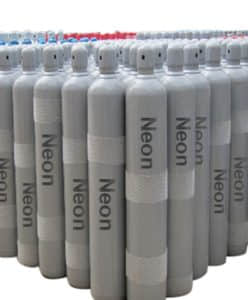Introduction
Neon (Ne) is a noble gas with a variety of industrial applications, from lighting and electronics to cryogenics and medical imaging. While Neon is generally considered inert and non-toxic, it is crucial to handle and store it with care to ensure safety and product integrity. In this comprehensive guide, we will delve into the recommended storage and handling precautions provided by Neon suppliers to maintain the quality and safety of this valuable gas.

General Safety Precautions for Neon (Ne) Handling
Neon, being an inert and non-toxic gas, presents specific safety considerations for handling
- Understanding the Properties of Neon
Neon is an odorless, colorless, and non-toxic gas, which makes it relatively safe to handle. However, it is essential to be aware of its other properties, such as:
Flammability and Potential Hazards
Neon is not flammable on its own, but it can act as a simple asphyxiant in high concentrations by displacing oxygen. This makes proper ventilation and monitoring of confined spaces crucial.
- Personal Protective Equipment (PPE) Requirements
To ensure safety during Neon handling, the following PPE is recommended:
Recommended PPE for Handling Neon
Safety goggles or face shield to protect eyes from splashes or leaks
Chemical-resistant gloves to prevent skin contact
Protective clothing to shield against potential exposure
Respiratory protection in case of accidental release or exposure to high concentrations
Storage Recommendations for Neon (Ne)
Proper storage of Neon is essential to maintain its purity and prevent potential hazards:
- Suitable Storage Containers and Systems
Choosing the right storage container is critical for the safe handling of Neon:
Types of Containers Recommended for Neon Storage
High-pressure cylinders designed for compressed gases
Cryogenic storage tanks for liquid Neon (Neon liquefies at -245.95°C)
Importance of Leak-proof and Pressure-resistant Containers
Ensuring containers are leak-proof to prevent gas loss and potential hazards
Use of pressure-resistant containers to handle high-pressure Neon safely
- Storage Conditions
Maintaining the right storage conditions is vital for the longevity and safety of Neon:
Recommended Temperature and Pressure Conditions
Storage temperature should be stable and within the specified range (approximately -246°C for liquid Neon)
Maintain consistent pressure levels within the storage container
Protection from Direct Sunlight and Other Environmental Factors
Store Neon away from direct sunlight to prevent excessive temperature fluctuations
Protect from exposure to moisture and corrosive substances that can compromise the purity of Neon
- Storage Location Considerations
The location of Neon storage plays a crucial role in ensuring safety:
Indoor vs. Outdoor Storage
Indoor storage is generally recommended to protect Neon from environmental factors and potential theft or tampering
If outdoor storage is unavoidable, ensure adequate protection from the elements and potential hazards
Separation from Incompatible Materials and Hazardous Substances
Store Neon away from oxidizing agents, flammable materials, and other incompatible substances to prevent potential reactions and hazards
Handling Precautions for Neon (Ne)
Safe handling of Neon is essential to prevent leaks, spills, and exposure:
- Safe Handling Procedures
Follow these guidelines to ensure safe handling of Neon:
Guidelines for Transferring Neon Between Containers
Use specialized equipment and transfer methods to minimize the risk of leaks and spills
Perform transfers in well-ventilated areas to prevent the accumulation of Neon in confined spaces
Handling Precautions to Prevent Leaks and Spills
Regularly inspect storage containers and equipment for signs of wear, damage, or leaks
Use proper fittings, seals, and connections to ensure a secure and leak-free system
- Transportation and Shipping Precautions
Proper transportation is crucial to ensure the safety of Neon during transit:
Secure and Compliant Transportation Methods
Use specialized vehicles designed for transporting compressed gases or cryogenic liquids
Ensure compliance with local, state, and federal regulations governing the transportation of hazardous materials
Vehicle Requirements and Safety Measures for Neon Transportation
Vehicles should be equipped with secure storage compartments, ventilation systems, and emergency response equipment
Drivers should be trained in the safe handling and transportation of hazardous materials, including Neon
- Emergency Response and Spill Control
In the event of a leak or spill, proper emergency response measures must be implemented:
Emergency Procedures in Case of Leaks or Spills
Evacuate the area and secure the leak source to prevent further release of Neon
Ventilate the area to disperse the gas and reduce the risk of asphyxiation
Spill Control Measures and Containment Strategies
Use absorbent materials and containment barriers to control and contain the spill
Dispose of contaminated materials in accordance with local regulations and guidelines
Regulatory Compliance and Certification Requirements
Adherence to industry standards and regulations is essential for ensuring the safe and compliant handling of Neon:
- Adherence to Industry Standards and Regulations
Compliance with Occupational Safety and Health Administration (OSHA) Regulations
Ensure compliance with OSHA regulations governing the handling, storage, and transportation of compressed gases and cryogenic liquids
Implement safety training programs and procedures to minimize the risk of accidents and injuries
Alignment with Industry-specific Safety Standards and Guidelines
Comply with industry-specific standards and guidelines, such as those provided by the Compressed Gas Association (CGA) or the National Fire Protection Association (NFPA)
Regularly review and update safety procedures and protocols to reflect current industry standards and best practices
- Training and Certification for Personnel
Proper training and certification of personnel are crucial for ensuring the safe handling and management of Neon:
Required Training for Employees Handling Neon
Provide comprehensive training programs covering the properties of Neon, safe handling procedures, emergency response measures, and regulatory compliance
Regularly assess and update training programs to reflect changes in regulations, technology, and best practices
Certification Programs and Refresher Training for Safe Handling Practices
Require employees to obtain and maintain relevant certifications, such as Hazardous Materials (HAZMAT) handling certification or Cryogenic Safety certification
Implement refresher training programs to reinforce safe handling practices and ensure ongoing compliance with regulatory requirements
Conclusion
Proper storage and handling of Neon are essential to maintain its purity, ensure safety, and comply with regulatory requirements. By following the recommended precautions and guidelines provided by Neon suppliers, companies can minimize risks, prevent accidents, and ensure the reliable supply of high-quality Neon for their operations.


